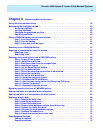
Introduction to Disk Mirroring CentreVu CMS Release 3 Version 8 Disk-Mirrored Systems
Disk mirroring defined 1
1
Introduction to Disk Mirroring1
This chapter introduces you to “disk mirroring,” an optional
feature of CentreVu
Call Management System (CMS) that
provides you with a completely redundant set of data, helping
to ensure data security. To use disk mirroring, you must have a
Sun
*
Enterprise
*
3000 or Sun Enterprise 3500 platform running
CMS r3v8.
Disk mirroring defined 1
“Mirrors” are a feature of the
Solstice DiskSuite
*
software package. They
allow you to build a hard disk system containing two—or even three—
complete sets of data. Having such data redundancy greatly reduces the
risk of data loss should a hard disk drive fail or your system crash. While
mirrors greatly reduce the risk of losing data, however, they are not
meant to be a substitute for regular backups. Mirrored systems must be
backed up just as often as unmirrored systems.
Metadevices 1
The
Solstice DiskSuite
software package allows multiple disk partitions to
be logically combined to create a single large partition. Using the
Solstice
DiskSuite
package allows CMS databases to span multiple disks, and so
grow quite large.
Solstice DiskSuite
uses virtual disks to manage physical disks and their
associated data. In
Solstice DiskSuite
, a virtual disk is called a
metadevice. To a software application, a metadevice is identical to a
physical disk drive.
Solstice DiskSuite
handles all I/O requests directed at
a metadevice, converting them into I/O requests for the underlying disks.
Solstice DiskSuite
metadevices are built from slices (disk partitions). A
system controlled by
Solstice DiskSuite
may contain any number of
metadevices, each of which may comprise any combination of disk
partitions.
Once a metadevice has been set up, the underlying disk partitions
can be accessed only through the metadevice.
*
Sun
,
Enterprise
, and
Solstice
DiskSuite
are trademarks or registered trademarks of Sun Microsystems, Inc.


















